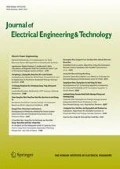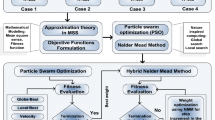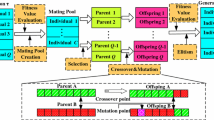Abstract
Designing the time domain training sequences is very critical in multi carrier transmission which degrades the performance as it is contaminated by different blocks in different cells. To improve the spectral efficiency and high accuracy, MU-MIMO needs the sensing matrix to be reduced by using the training sequence design and optimization. Integrating the training sequence design and sparse channel estimation improves the capacity of the system. The capacity can be enhanced by reducing the bit error rate. The system capacity for multi user- multi-input and multi output (MU-MIMO) is studied by proper channel estimation with compressed sensing model. The design and optimization of training sequence is analysed for MU-MIMO model using auto coherence and block coherence matrices. The block coherence matrix is optimized using cuckoo algorithm for obtaining lower coherence value for different sparsity values. The performance improvement in terms of signal to noise ratio is 1 dB for single user- multi-input and multi output (SU-MIMO) using genetic algorithm and the performance of MU-MIMO is observed to be 0.93 dB using cuckoo algorithm.













Similar content being viewed by others
Abbreviations
- \(h_{l}\) :
-
Channel vector of lth user
- \(\tilde{h}_{l}\) :
-
Channel matrix
- \(\tilde{h}_{lbest}\) :
-
Lowest coherence Value of block coherence matrix
- \(K\) :
-
Number of Users
- \(M\) :
-
Number of Base station antennas
- \(p\) :
-
Degree of perfection
- \(R_{l}\) :
-
Hermitian Matrix
- \(R_{sum}\) :
-
Achievable Sum rate
- s n :
-
Transmitted Symbol
- V :
-
Rician factor
- W :
-
Weight factor
- \(w_{l}\) :
-
Optimal beam forming Vector
- \(w_{n}\) :
-
Normalized vector
- \(\varepsilon\) :
-
Channel reliability
- \(\varepsilon_{c}\) :
-
Critical reliability
- \(\varphi g\) :
-
Sensing Matrix
- \(\mu_{B} (\varphi )\) :
-
Block coherence matrix
- \(\mu_{B} (\varphi_{\alpha } ,\varphi_{\beta } )\) :
-
Lower bound of Block coherence Matrix
- \(\theta_{l}\) :
-
Angle of departure
- \(\sigma^{2}\) :
-
Variance
- BER:
-
Bit error rate
- MU-MIMO:
-
Multi User Multi input and multi output
- SINR:
-
Signal to interference plus noise ratio
- SLNR:
-
Signal to leakage noise ratio
- ZF:
-
Zero Forcing
- MRT:
-
Maximum ratio transmission
- SISO:
-
Single input single output
- LOS:
-
Line of sight
- IDFT:
-
Inverse discrete Fourier transform
- SVD:
-
Single value Decomposition
- CSI:
-
Channel state Information
- IDFT:
-
Inverse discrete Fourier Transform
References
Marzetta TL (2010) Noncooperative cellular wireless with unlimited numbers of base station antennas. IEEE Trans Wireless Commun 9(11):3590–3600
Ashikhmin A, Marzetta T (2012) Pilot contamination precoding in multi-cell large scale antenna systems. In: 2012 IEEE international symposium on information theory proceedings, IEEE, pp 1137–1141
Li M, Jin S, Gao X (2013) Spatial orthogonality-based pilot reuse for multi-cell massive MIMO transmission. In: 2013 international conference on wireless communications and signal processing, IEEE, pp 1–6
Björnson E, Hoydis J, Sanguinetti L (2017) Massive MIMO has unlimited capacity. IEEE Trans Wireless Commun 17(1):574–590
Zhao L, Zheng K, Yang H, Xiang W (2016) Beamformer design and utility optimization for hybrid information and energy transfer with massive MIMO. IEEE Syst J 12(2):1981–1992
Zhou X, Zhang R, Ho KC (2013) Wireless information and power transfer: Architecture design and rate-energy tradeoff. IEEE Trans Commun 61(11):4754-4767.–5
Zhang R, Ho CK (2013) MIMO broadcasting for simultaneous wireless information and power transfer. IEEE Trans Wireless Commun 12(5):1989–2001
Varshney LR (2008) Transporting information and energy simultaneously. In: 2008 IEEE international symposium on information theory, IEEE, pp 1612–1616
Liu L, Zhang R, Chua K-C (2012) Wireless information transfer with opportunistic energy harvesting. IEEE Trans Wirel Commun 12(1):288-300.–6
Park J, Clerckx B (2013) Joint wireless information and energy transfer in a two-user MIMO interference channel. IEEE Trans Wirel Commun 12(8):4210-4221.–16
Ju H, Zhang R (2014) Optimal resource allocation in full-duplex wireless-powered communication network. IEEE Trans Commun 62(10):3528-3540.–19
Kang X, Ho CK, Sun S (2015) Full-duplex wireless-powered communication network with energy causality. IEEE Trans Wireless Commun 14(10):5539–5551
Chen X, Yuen C, Zhang Z (2013) Wireless energy and information transfer tradeoff for limited-feedback multiantenna systems with energy beamforming. IEEE Trans Veh Technol 63(1):407–412
Tien Ngoc HA, Kha HH (2019) Harvested energy and spectral efficiency trade-offs in multicell MIMO wireless networks. Radioengineering 28(1):331
Senel K, Björnson E, Larsson EG (2019) Joint transmit and circuit power minimization in massive MIMO with downlink SINR constraints: when to turn on massive MIMO? IEEE Trans Wirel Commun 18(3):1834–1846
Ma X, Yang F, Liu S, Song J, Han Z (2017) Design and optimization on training sequence for mmWave communications: a new approach for sparse channel estimation in massive MIMO. IEEE J Sel Areas Commun 35(7):1486–1497
Patel SM, Bhatt KR (2019) Meta-heuristic algorithm based precoding in massive MIMO. Wirel Personal Commun 110:1–27
Ren Y, Lv T, Gao H, Yang S (2016) Wireless information and energy transfer in multi-cluster MIMO uplink networks through opportunistic interference alignment. IEEE Access 4:3100–3111
Tebe PI, Kuang Y, Opare KA, Kponyo JJ (2015) The effect of channel estimation errors on the energy efficiency of downlink massive MIMO systems. In: 2015 seventh international conference on ubiquitous and future networks, IEEE, pp 963–968
Tebe PI, Kuang Y, Opare KA, Kponyo JJ (2015) The optimum number of base station antennas in an energy efficient downlink massive MIMO system. In: 2015 IEEE international conference on communication, networks and satellite (COMNESTAT), IEEE, pp 105–110
Parfait T, Kuang Y, Jerry K (2014) Performance analysis and comparison of ZF and MRT based downlink massive MIMO systems. In: 2014 sixth international conference on ubiquitous and future networks (ICUFN), IEEE, pp 383–388
Chen X, Wang X, Chen X (2013) Energy-efficient optimization for wireless information and power transfer in large-scale MIMO systems employing energy beamforming. IEEE Wirel Commun Lett 2(6):667–670
Yang G, Ho CK, Zhang R, Guan YL (2015) Throughput optimization for massive MIMO systems powered by wireless energy transfer. IEEE J Sel Areas Commun 33(8):1640–1650
Lin Y, Li X, Fu W, Hei Y (2015) Spectral efficiency analysis for downlink massive MIMO systems with MRT precoding. China Commun 12(Supplement):67–73
Zhang Y, Ji C, Malik WQ, O’Brien DC, Edwards DJ (2007) Cross-entropy optimisation of multiple-input multiple-output capacity by transmit antenna selection. IET Microwaves Antennas Propag 1(6):1131–1136
Jiang X, Xie M-C, Wei J, Wang K-P, Peng L (2019) 3D-MIMO beamforming realised by AQCUCKOO algorithm for cylindrical conformal phased array. IET Microwaves Antennas Propag 13(15):2701–2705
Deng C, Lv X (2019) Wideband MIMO antenna with small ground clearance for mobile terminals. IET Microwaves Antennas Propag 13(9):1419–1426
Ding D, Wang G, Wang L (2015) High-efficiency scheme and optimisation technique for design of fragment-type isolation structure between multiple-input and multiple-output antennas. IET Microwaves Antennas Propag 9(9):933–939
Wang X, Chen W, Zheng J, Shen Y, Feng Z (2011) Design and preliminary evaluation of a compact four-element terminal multiple-input multiple-output antenna for receiving antenna selection. IET Microwaves Antennas Propag 5(7):756–763
Björnson E, Sanguinetti L, Hoydis J, Debbah M (2014) Designing multi-user MIMO for energy efficiency: When is massive MIMO the answer? In: 2014 IEEE wireless communications and networking conference (WCNC), pp 242–247
Sande MM, Maharaj BT (2018) Efficient robust beamforming for downlink transmission in massive MIMO systems. In: 2018 IEEE 87th vehicular technology conference (VTC Spring), pp 1–5
Zhao L, Wang X, Zheng K (2015) Downlink hybrid information and energy transfer with massive MIMO. IEEE Trans Wireless Commun 15(2):1309–1322
Ngo HQ, Larsson EG, Marzetta TL (2013) Energy and spectral efficiency of very large multiuser MIMO systems. IEEE Trans Commun 61(4):1436–1449
He K, Wang Z, Li D, Zhu F, Fan L (2020) Ultra-reliable MU-MIMO detector based on deep learning for 5G/B5G-enabled IoT. Phys Commun 43:101181
Tsinos CG, Domouchtsidis S, Chatzinotas S, Ottersten B (2020) Symbol level precoding with low resolution DACs for constant envelope OFDM MU-MIMO systems. IEEE Access 8:12856–12866
Abdo AMA, Zhao X, Zhang R, Zhou Z, Zhang J, Zhang Y, Memon I (2018) MU-MIMO downlink capacity analysis and optimum code weight vector design for 5G big data massive antenna millimeter wave communication. Wirel Commun Mobile Comput 2018:1–12
Jiang S, Yuan X, Wang X, Xu C, Yu W (2020) Joint user identification, channel estimation, and signal detection for grant-free NOMA. IEEE Trans Wireless Commun 19(10):6960–6976
Huang Y, Wu Q, Lu R, Peng X, Zhang R (2021) Massive MIMO for cellular-connected UAV: challenges and promising solutions. IEEE Commun Mag 59(2):84–90
Sohrabi F, Attiah KM, Yu W (2021) Deep learning for distributed channel feedback and multiuser precoding in FDD massive MIMO. IEEE Trans Wirel Commun. https://doi.org/10.1109/TWC.2021.3055202
Nguyen LV, Swindlehurst AL, Nguyen DHN (2021) SVM-based channel estimation and data detection for one-bit massive MIMO systems. IEEE Trans Signal Process 69:2086
Zhang J, Ma X, Qi J, Jin S (2021) Designing tensor-train deep neural networks for time-varying MIMO channel estimation. IEEE J Sel Top Signal Process 15(3):759–773
Funding
Not Received.
Author information
Authors and Affiliations
Corresponding author
Ethics declarations
Conflict of interest
All authors declare that they have no conflict of interest.
Additional information
Publisher's Note
Springer Nature remains neutral with regard to jurisdictional claims in published maps and institutional affiliations.
Rights and permissions
About this article
Cite this article
Ramisetty, U.M., Chennupati, S.K. & Gundavarapu, V.N. Design of Training Sequences for Multi User—MIMO with Accurate Channel Estimation Considering Channel Reliability Under Perfect Channel State Information Using Cuckoo Optimization. J. Electr. Eng. Technol. 16, 2743–2756 (2021). https://doi.org/10.1007/s42835-021-00778-6
Received:
Revised:
Accepted:
Published:
Issue Date:
DOI: https://doi.org/10.1007/s42835-021-00778-6




